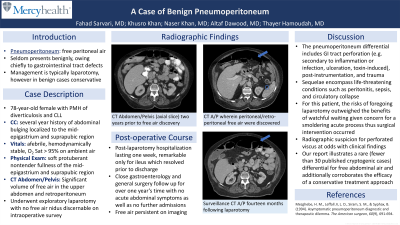Tuesday Poster Session
Category: Colon
P3082 - A Case of Benign Pneumoperitoneum
Tuesday, October 24, 2023
10:30 AM - 4:00 PM PT
Location: Exhibit Hall

Has Audio

Fahad Sarvari, MD
MercyHealth
Rockford, IL
Presenting Author(s)
Fahad Sarvari, MD, Khusro Khan, , Naser Khan, MD, Altaf Dawood, MD, MBBS, Thayer Hamoudah, MD
MercyHealth, Rockford, IL
Introduction: Pneumoperitoneum seldom presents benignly, owing chiefly to defects within the gastrointestinal tract. Though definitive management typically requires laparotomy, treatment in benign cases is supportive and non-operative. Here, we present a case of benign pneumoperitoneum wherein surgical intervention revealed no perforation and conservative therapy has been successful to date.
Case Description/Methods: A 78-year-old female with history of diverticulosis and CLL presented to her PCP with concern for an abdominal hernia. Surgical referral was placed and the patient underwent CT abdomen which showed a considerable amount of free air in the upper abdomen as well as the retroperitoneum. Official radiology report deduced bowel perforation as the etiology though the patient was asymptomatic, afebrile, hemodynamically stable, and laboratory work up demonstrated no leukocytosis. Surgical evaluation culminated in the decision to pursue exploratory laparotomy out of concern for impending acute abdomen. Intraoperatively there was no discernable free air nidus thus the etiology was concluded to be indeterminate and the patient discharged to home after one week of post-operative care. The patient has maintained close outpatient gastroenterology and surgical follow up for one year. Though pneumoperitoneum persists on her abdominal imaging, clinical signs of peritonitis have consistently been absent corroborating both efficacy of a conservative treatment approach as well as the diagnosis of “benign” pneumoperitoneum.
Discussion: The pneumoperitoneum differential diagnosis includes perforation of the gastrointestinal tract, post-instrumentation, as well as trauma. Its sequelae encompass life-threating conditions such as peritonitis and shock. In our patient, though radiographic index of suspicion for bowel perforation was high, clinical evidence of peritonitis was notably absent. Nonetheless, because the risks of foregoing laparotomy outweighed the benefits of observation given concern for a smoldering acute process, surgical intervention occurred. Fortunately, the patient’s post-operative course was routine and to date there has been no worsening of her condition while on a conservative management pathway. This case of benign pneumoperitoneum adds a necessary report of a rare differential for the radiographic finding of free abdominal air. Delineating between acute and subacute etiologies can prevent unnecessary surgical morbidity. To date, a literature review reveals less than 30 reported cryptogenic cases.
Disclosures:
Fahad Sarvari, MD, Khusro Khan, , Naser Khan, MD, Altaf Dawood, MD, MBBS, Thayer Hamoudah, MD. P3082 - A Case of Benign Pneumoperitoneum, ACG 2023 Annual Scientific Meeting Abstracts. Vancouver, BC, Canada: American College of Gastroenterology.
MercyHealth, Rockford, IL
Introduction: Pneumoperitoneum seldom presents benignly, owing chiefly to defects within the gastrointestinal tract. Though definitive management typically requires laparotomy, treatment in benign cases is supportive and non-operative. Here, we present a case of benign pneumoperitoneum wherein surgical intervention revealed no perforation and conservative therapy has been successful to date.
Case Description/Methods: A 78-year-old female with history of diverticulosis and CLL presented to her PCP with concern for an abdominal hernia. Surgical referral was placed and the patient underwent CT abdomen which showed a considerable amount of free air in the upper abdomen as well as the retroperitoneum. Official radiology report deduced bowel perforation as the etiology though the patient was asymptomatic, afebrile, hemodynamically stable, and laboratory work up demonstrated no leukocytosis. Surgical evaluation culminated in the decision to pursue exploratory laparotomy out of concern for impending acute abdomen. Intraoperatively there was no discernable free air nidus thus the etiology was concluded to be indeterminate and the patient discharged to home after one week of post-operative care. The patient has maintained close outpatient gastroenterology and surgical follow up for one year. Though pneumoperitoneum persists on her abdominal imaging, clinical signs of peritonitis have consistently been absent corroborating both efficacy of a conservative treatment approach as well as the diagnosis of “benign” pneumoperitoneum.
Discussion: The pneumoperitoneum differential diagnosis includes perforation of the gastrointestinal tract, post-instrumentation, as well as trauma. Its sequelae encompass life-threating conditions such as peritonitis and shock. In our patient, though radiographic index of suspicion for bowel perforation was high, clinical evidence of peritonitis was notably absent. Nonetheless, because the risks of foregoing laparotomy outweighed the benefits of observation given concern for a smoldering acute process, surgical intervention occurred. Fortunately, the patient’s post-operative course was routine and to date there has been no worsening of her condition while on a conservative management pathway. This case of benign pneumoperitoneum adds a necessary report of a rare differential for the radiographic finding of free abdominal air. Delineating between acute and subacute etiologies can prevent unnecessary surgical morbidity. To date, a literature review reveals less than 30 reported cryptogenic cases.
Disclosures:
Fahad Sarvari indicated no relevant financial relationships.
Khusro Khan indicated no relevant financial relationships.
Naser Khan indicated no relevant financial relationships.
Altaf Dawood indicated no relevant financial relationships.
Thayer Hamoudah indicated no relevant financial relationships.
Fahad Sarvari, MD, Khusro Khan, , Naser Khan, MD, Altaf Dawood, MD, MBBS, Thayer Hamoudah, MD. P3082 - A Case of Benign Pneumoperitoneum, ACG 2023 Annual Scientific Meeting Abstracts. Vancouver, BC, Canada: American College of Gastroenterology.
